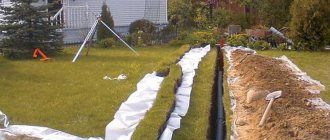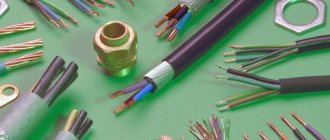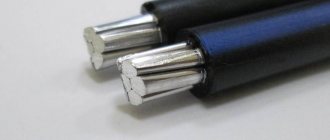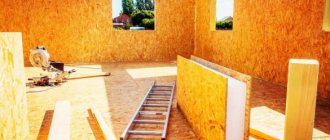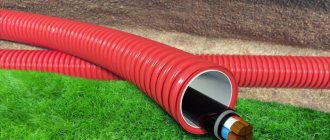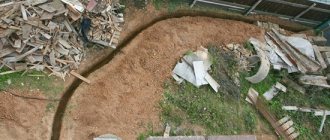Often, laying a cable in the ground causes panic and mental images of a huge number of difficulties. In fact, this is a fairly simple task that a beginner can handle. We will figure out how to choose a cable, at what distance from buildings to lay it, how to fill trenches and how to make sure that it does not bend during use. We will also consider what to do if it is necessary to lay it in winter.
Wire with insulation Source www.avtomats.com.ua
Selecting cable for underground installation
For high-quality operation of the electrical network, you need to choose the right wires. Cable brands are always selected taking into account technical conditions and the power network installation plan. For soil without excess moisture, it is better to take VBSV with a PVC sheath.
PvBShp power cables with insulation, an armored layer and a hose made of protective material are suitable for soil with high humidity or close proximity to groundwater. For cold ground, it is advisable to use the VKaShvng(A)-KhL brand with reinforced armor.
Also, several more cables are suitable for laying underground:
- AVVG and VVG with operating voltage up to 1000 V (made of aluminum or copper without armor, in PVC insulation and sheath);
- AVBbShv (there is a core version made of different materials in PVC insulation and sheath).
Cables of the VVG or AVVG brands for laying in the ground are recommended to be used only under certain conditions:
- if the load by tension on the wire is excluded, which can be in soft or shifting soils, as well as on vertical surfaces;
- if the trenches are not highly corrosive, and also with or without stray currents.
Cables with operating voltages up to 1000 V do not need to be protected with hard layers (brick, concrete slab). This is only necessary where there is a high probability of excavation. It is not necessary to protect the network at a laying depth of 1 - 1.2 m. It is recommended to use an armored electrical cable for laying in the ground.
Options without protection must fit into pipes and be resistant to mechanical damage. For better distribution of voltage throughout the network and increased protection against overloads, you can install a 3-phase wire instead of an analogue with 1 core.
Its disadvantage is the increase in the size of the electrical panel due to the larger number of forced shutdown devices, and it also requires a special three-way circuit breaker. But all the shortcomings are compensated by the stability of the network and the ability to connect asynchronous devices, boilers and heating systems.
Unarmored wire Source www.cabeltov.ru
Underground cable installation technology
Laying an electrical cable in the ground at a summer cottage, the territory of a private household or other facility begins with excavation work. Before this, you need to decide on the depth and width of the trench. The depth must be at least 80 cm, and the width 30 cm for each cable, if there are several of them. In accordance with the developed plan and route markings, soil sampling is carried out. The trench is cleared of foreign hard and sharp objects, and its walls should have a slight slope. After excavation work is completed, the cable is laid according to the following algorithm:
- the bottom of the trench is leveled, covered with sand in a layer of 15 cm and compacted;
- Protective cases are placed on the prepared pillow, if necessary;
- the cable is pulled through the cases, maintaining the required slack;
- the protection pipes are connected into one whole in one of several ways;
- a layer of sand 25 cm thick is poured on top of the laid cable in protection;
- the top filling is slightly compacted, preferably with your own feet;
- plastic warning tape must be laid with the lettering facing up;
- the trench is filled with soil, layer by layer, with mandatory compaction.
Attention! Don't rush to bury the cable! Be sure to invite a representative of the energy company that gives permission to connect to public electrical networks. You can carry out underground laying and installation of the necessary equipment yourself, but authorized power engineers must check for compliance with GOSTs and PUE (electrical installation rules)!
It is advisable to lay the cable in one single piece, without any connections. If this option cannot be implemented, then the individual pieces must be connected in mounting boxes specially designed for outdoor use. The device is installed on a post above the soil surface, at the junction of the cable, where its ends are brought to the surface. Do not bury the box, as this will quickly damage the line.
At this point, the laying of cable lines in the ground ends and the stage of connecting underground electrical communications to the general power supply networks and input into buildings located on the site begins. Each stage of work, both when laying the cable and connecting it, has its own nuances, which will be highlighted below. We will begin this description with the choice of cable for underground routes.
Requirements for proper electrical installation
A certain distance is required to lay the cable. The depth of the trench, taking into account the 10 cm sand cushion, should be:
- from 0.8 m;
- from 1.1 m under the roadway;
- up to 60 cm when entering the building.
This depth is necessary to protect the cable:
- from temperature changes;
- from uneven pressure;
- from people who may be digging something in the cable area.
There is a misconception that such a distance is necessary due to soil freezing. But this is not true, because during the winter the ground freezes 10-80 cm in cold areas.
Trench for laying Source vashtehnik.ru
Maintaining distance from objects
There are certain distance standards that must be observed when laying cables in parallel near other objects:
- There can be any distance between control cables to an adjacent cable, from a power cable to any other – from 10 cm, and for wires from a third party – from 50 cm.
- The distance to the foundations of country buildings must be at least 60 cm, and laying cables under them is prohibited. The space between trees and the wire should be from 2 m (if in a pipe, you can dig under the tree), and to bush plants - from 75 cm.
- The distance to any gas or water pipes must be at least 2 m.
- The distance to the railway should not be less than the declared exclusion zone, to the axis of the tram tracks 2.75 m, and to the curb of the road 1.5 m.
It is important to maintain these distances to avoid fatal situations.
Intersecting networks Source slide-share.ru
Cable Laying Tips
There are different laying schemes for armored and unprotected cables:
- It is necessary to create a diagram according to which the wire will be laid. It indicates the distance to all objects near which the cable will pass. This designation will help you determine where the wire is laid so as not to touch it when working on the site. On the walls it is necessary to mark with paint the places where the cable is connected.
- Next, a trench is marked and dug. Lighting poles are installed and fixed.
- After this, you need to make a pillow from soft earth without hard objects. It is compacted and should be at least 10 cm.
- Then comes the laying of the cable, leaving a margin of length. You must use solid wire and do not use jumpers. If there is a load on the cable, then it is necessary to lay pipes so that it is inside.
- Next, the wire must be covered with soft earth without hard elements and compacted. The pillow should be 10 cm high.
- It is necessary to fill the trench with fluffy soil, taking into account the fact that after winter and rains it will settle.
- You need to check for short circuits using a multimeter.
See also: Catalog of companies that specialize in the installation of electrical networks
It is advisable to choose a cable for laying in the ground at the dacha, a 220V brand, in order to avoid problems with power supply. If the trench is not completely buried immediately, then it is necessary to clearly mark the cable. This is required to prevent health hazards.
Also, when laying, it is necessary to ensure a length reserve of 1-2%, which helps to prevent cable stretching. To do this, the wire can be laid in a snake. You cannot add extra length with rings, this can lead to a short circuit.
For pipes, it is better to use steel (corrosion-protected), rigid bendable options made of synthetic materials. Then the insides can simply be replaced.
Tape to mark the wire from below Source avg-ekb.ru
Laying cables in the ground
To bookmarks
Introduction
This article provides detailed, step-by-step instructions for laying cable lines with voltages up to 1000 Volts (1 kV) in the ground. It is better to entrust the laying of high-voltage cables to specialized organizations.
Despite the fact that laying a cable underground is more expensive than installing an overhead line, underground cable lines have a number of serious advantages, such as reliability and durability; in addition, such lines, when laid, will not spoil the aesthetic appearance of the area through which they pass.
Cable laying in the ground is carried out in the following order:
STEP 1. Cable selection.
The following types of cables are usually used for underground installation:
- AVVG - unarmored cable in polyvinyl chloride insulation with aluminum conductors;
- VVG - unarmored cable in polyvinyl chloride insulation with copper conductors;
- AVBbShv - armored cable in polyvinyl chloride insulation with aluminum conductors;
- VBBShV - armored cable in polyvinyl chloride insulation with copper conductors;
At the same time, in accordance with clause 2.3.37 of the PUE, armored cables (i.e., cables of the AVBbShv and VBbShv brands) should be predominantly used for laying in the ground.
After the cable brand there are two numbers: the first indicates the number of cores in the cable, the second - the cross-section of the cores. For example, the VBBShV 4x10 cable is an armored cable with four copper conductors with a cross-section of 10 mm2 in polyvinyl chloride insulation.
The number of cores is selected based on the type of network; for a three-phase network, cables with a number of cores of 4 are used (or 5 - for a network with a TN-S grounding system), for a single-phase network - cables with a number of cores of 2 (or 3 - for a network with a TN grounding system -S).
The cross-section of the cores is selected based on the load power. The cross section can be calculated using our online calculator.
NOTE: When using an armored cable for laying in the ground, its armor must be grounded (zeroed) (clause 2.3.71. PUE), this is done by connecting the cable armor to the grounding bus (PE bus) of the electrical panel to which it is connected.
STEP 2. Determining the route for laying the cable across the site. Let's draw a layout diagram.
When determining the route of underground cable laying, the following requirements of the PUE must be taken into account:
- The cable laying route should be selected taking into account the lowest cable consumption and ensuring its safety under mechanical stress. When placing cables, you should avoid crossing them with each other, with pipelines, etc. (clause 2.3.14.);
- The clear distance from a cable laid directly in the ground to the foundations of buildings and structures must be at least 0.6 m. Laying cables directly in the ground under the foundations of buildings and structures is not allowed (clause 2.3.85.);
- When laying cable lines in a planted area, the distance from the cables to the tree trunks should, as a rule, be at least 2 m. This distance can be reduced if the cables are laid in pipes laid by digging. When laying cables within a green zone with shrub plantings, the specified distances can be reduced to 0.75 m (clause 2.3.87.);
- When laying parallel, the horizontal clear distance from cable lines to pipelines, water supply, sewerage and drainage, as well as gas pipelines with a pressure of up to 0.588 MPa must be at least 1 m, and to gas pipelines with a pressure of more than 0.588 MPa and heat pipelines - at least 2 m ( pp. 2.3.88. 2.3.89.);
- When laying a cable line parallel to overhead lines (OHL), the distance from the cable to the vertical plane passing through the outermost wire of the line must be at least 1 m for overhead lines up to 1 kV, at least 5 m for overhead lines up to 35 kV, at least 10 m - for overhead lines 110 kV and above (clause 2.3.93.);
After the route has been drawn up, we draw a plan of the area along which the cable will be laid, with a diagram for laying the cable itself, be sure to indicate the bindings - the distances from the buildings to the cable being laid. In the future, this plan will help to avoid damage to the cable during excavation work on the site, or to quickly find a cable to repair it if damaged:
The cable laying diagram can also be drawn after the fact, after it has been laid, or after the trench has been dug.
STEP 3. Digging a trench and laying cables.
In accordance with clause 2.3.84. PUE, the depth of cable lines from the planning mark must be at least 0.7 meters, and at the intersection of streets and squares - 1 m.
Cables up to 1 kV in areas where mechanical damage is likely (for example, in places of frequent excavations) must be protected from mechanical damage by covering them with reinforced concrete slabs or ordinary clay bricks in one layer across the cable route along the cable line route. The use of silicate, as well as clay hollow or perforated bricks is not allowed.
However, when laying cables at a depth of 1-1.2 m (except for cables of city electrical networks), it is allowed not to protect them from mechanical damage (clause 2.3.83. PUE), therefore, to reduce material costs for additional protection of the cable from mechanical damage, the trench should be dug at depth 1.2 meters.
In turn, there are no special requirements for the width of the trench; however, when laying several cables in parallel in one trench, its width should allow them to be laid at a horizontal distance of at least 100 mm from each other (clause 2.3.86. PUE)
According to clause 2.3.83. PUE when laying cable lines directly in the ground, cables in trenches must be backfilled at the bottom and backfilled with a layer of fine earth that does not contain stones, construction waste and slag on top.
For additional protection of the cable from accidental damage above the cable at a distance of 250 mm from its outer cover. When placing one cable in a trench, the tape must be laid along the axis of the cable; with a larger number of cables, the edges of the tape must protrude beyond the outermost cables by at least 50 mm. When laying more than one tape across the width of a trench, adjacent tapes must be laid with an overlap of at least 50 mm wide. (Note: when laying at a depth of more than 1 meter, this requirement is not mandatory ).
The cable in the trench must be laid with a reserve length sufficient to compensate for possible soil displacements and temperature deformations of the cables themselves and the structures along which they are laid, while laying the reserve cable in the form of rings (turns) is prohibited (clause 2.3.15. PUE) .
From the above it follows that the cable should be laid in the trench in waves (“snake”):
IMPORTANT! Before burying the cable, it should be checked for damage; this can be done by testing its cores using a conventional multimeter.
After checking the cable for damage, sprinkle 25 cm of sand or sifted soil on top of it, if necessary, lay down signal tape and finally fill the trench with soil as shown in the picture above.
STEP 4. Inserting the cable line into the building
When entering a cable line into a building, if necessary, it is allowed to reduce the depth of its installation to 0.5 m at a distance of no more than 5 m to the entry itself (clause 2.3.84. PUE).
When introducing an underground cable into a building along with the input, it must be protected from mechanical damage at a height of 2 m from the floor or ground level and 0.3 m in the ground (clause 2.3.15. PUE), this protection is provided by a metal corner or pipe:
In places where the cable passes through the walls, to protect it from mechanical damage, special bushings or pieces of metal pipes must be installed, and to prevent moisture from entering through the cable passage in the wall, it should be sealed using non-flammable filler or a special heat-shrinkable sealant for the cable passages.
Was this article useful to you? Or maybe you still have questions ? Write in the comments!
Didn’t find an article on the website on a topic that interests you regarding electrical engineering? Write to us here. We will definitely answer you.
↑ Up
5
https://elektroshkola.ru/elektroprovodka/prokladka-kabelya-v-zemle/
Connecting the network to your home
To correctly connect the cable to the house, you need to follow a certain procedure:
- it is required to dig a trench with a depth of 0.7 m to 1 m;
- Next, a pillow is made about 20 cm thick to remove moisture;
- then the cable is laid in waves in the ground (according to the PUE), release from the pole is carried out in a pipe 2 m high;
- After this, you need to run the wire to the electrical panel through the wall or foundation.
If you use the first option, then you need to make a hole and lay a pipe in it, through which you will pull the electrical network. If you pass the wire through the foundation, the sequence does not change, except that the pipe is fixed with a cement solution and insulated on both sides with non-flammable material. This will help prevent soil and moisture from entering through the hole.
Underground cable route design
The owner receives a plan of the route from the pole to the building along with the project for connecting to the electrical networks, but he carries out the wiring along the site to the bathhouse, garage and other objects independently. The most economical option is to lay the cable in a straight line, but in reality this is rarely feasible, since you will have to work around various obstacles. When developing a plan for laying underground cables across a site, the following rules must be followed.
- If possible, avoid intersection with other communications. If this can be done, then the cable without a protective sheath must be placed at a distance of no closer than 0.5 m from gas, water and sewer pipes. When laying the conductor in a casing, this distance is reduced to 0.25 m. When crossing with another electrical cable, this parameter is 15 cm.
- It is necessary to bypass parking areas and vehicle entry areas. If this condition cannot be met, then it is necessary to increase the depth of the trench or pass the cable through a protective case. Large trees and bushes should be avoided. When passing the route along the foundation, the distance from it must be at least 60 cm.
As a result, the cable laying plan will correspond to a broken line, not a straight line. Marking the trench is best done with a stream of sand or pegs. After the preparatory work, it is necessary to once again check the plan for compliance with the standards and transfer it to paper, linking it to all objects on the site and underground utilities.
This drawing will subsequently be useful during the construction of new facilities, redevelopment of the site, as well as in the event of a need to repair an underground power line, which can happen if the technology for laying an electric cable in the ground is not followed or in other force majeure circumstances. The plan has been developed, transferred to paper - it’s time to start the main work!
Advantages of underground wiring
Laying cables underground has a number of advantages over above-ground ones:
- Reducing the chance of network damage. If all installation standards are observed, the cable will be difficult to transfer or move, and its condition will not be affected by weather conditions and trees.
- It's easier to determine the length of the wire. If a cable is selected for underground installation, then during selection it is necessary to take into account the cross-section and length of the entire line. For an overhead cable, the weight and tension would have to be calculated to avoid overloading.
- Lower costs. To connect, you only need a forced network shutdown device, as well as small expenses for the project.
- Less risk of fire.
- Exposure to electromagnetic waves and thunderstorms is also reduced.
- Aesthetics. Since the wires are underground, the area can be used according to your preferences. The main thing is to remember where the wire is located so that there are no problems when planting trees.
Area before digging a trench Source s00.yaplakal.com
Advantages of laying cables underground
As mentioned above, laying an electrical cable in a pre-dug and prepared trench has only one advantage over air supply and no disadvantages in terms of reliability. Of course, all this is valid if the installation is carried out in compliance with all the rules. Let's look at the main advantages of this method of electrifying a private house, cottage or other facility.
- The possibility of using an electrical cable of a larger cross-section, so to speak, with a reserve, without the reinforcement of the supporting structure necessary for overhead lines.
- Minimization of all external devices such as switches, isolators and so on. It is enough to install one circuit breaker at the input to completely de-energize the internal electrical network.
- The aesthetics of the general appearance of the structure is also an important advantage of this connection option. Hanging and swinging wires do not add to the overall attractiveness of the building.
- If the trench is deep enough and communications are installed correctly, you can forget about the cable forever. The possibility of its failure and subsequent replacement is practically excluded.
How to lay a cable in the ground? The technology for such work is almost the same for all regions of the Russian Federation, with some nuances for different soils and climatic conditions. It is regulated by GOSTs and standards that have remained unchanged since the 60s of the last century. Laying cables underground at a dacha, in a private house or other low-rise building begins with the development of the route.
Winter styling
During the winter installation process, some difficulties may arise. Due to low temperatures, cracks may appear where the cable or pipe bends. This may lead to a ground fault or short circuit. In this case, laying a power cable will help, the installation of which can be carried out at -25 ° C.
If the temperature is too low, the cable needs to be warmed up. This will increase the elasticity of the wire and also reduce the risk of damage. For elasticity and flexibility, three heating methods are used:
- in a heated room (the wire warms up from 18 to 72 hours);
- setting up a tent and using heat guns;
- transformer (warms up to +20 °C directly during installation).
Video description
How to warm up the wire in winter conditions is shown in the video:
With any of these methods, it is necessary to seal the ends of the cable using special couplings to prevent condensation from penetrating.
The cable needs to be warmed up only after the entire line has been fully prepared, since in winter the installation of the electrical network is strictly regulated in terms of timing. Installation of a warm wire must be carried out at a certain time:
- 60 minutes – from 0 to -10 °C;
- 40 minutes from -10 to -20 °C;
- 30 minutes – from -20 and below.
A cable for laying in the ground that has been heated should not be bent too much. After installation, it must be covered with a small layer of fluffy earth and wait until it cools, and then bury the hole.
If your budget allows, you can purchase a cold-resistant cable (CL). It is designed for low temperatures and is not damaged by severe frosts. This cable has its advantages: a good range of temperature conditions for installation (from +50 ° C to -60 ° C), as well as use without heating in frost conditions of -25 ° C.
Cold-resistant wire Source hostingkartinok.com
Types of cable
Armored power
It holds the pressure of the top layer of soil well and is one of the best options for running a power line underground. The most popular type is a power cable armored with tapes, with a copper core, insulation and a protective hose made of PVC or VBShv.
VBShv cable
But it should be remembered that even such a well-protected conductor as VBShv should be used, focusing on the same PUE. Namely:
- Dig a trench that complies with the standards. Its average depth from the power line pole to the entrance to the house is 70 cm.
- Before laying the cable, cover the bottom of the trench with a 20-centimeter layer of sand - it will remove excess moisture and act as a shock absorber for the cable line.
- Lay the armored cable in a wave-like manner.
- Bring CL into the home. There are several methods available here - either through the foundation or through the wall. When running the cable through the foundation, you must first insert a plastic or metal tube into the entry hole. This is done to reduce the mechanical impact of foundation or wall elements on the cable sheath.
- Connect the cable line to the protective device in the electrical distribution panel and to the overhead line wires using piercing clamps.
- Organize grounding of the armored cable sheath.
- Check the correct connection, the integrity of the cable cable, and the absence of kinks or other “non-physiological” positions of the cable.
- Bury the trench, taking into account the gradual settlement of the soil. Accordingly, it should be filled in such a way that a small mound is formed on the surface - its reserves will be enough to prevent a failure.
Scheme of laying cables in a trench
Unarmored power
If suddenly for some reason (most often, of course, this is cost) it is not possible to use an armored cable, then it is allowed to enter the house through a VVG cable. But its installation must be carried out strictly in a HDPE pipe, which takes on the function of protection, that is, armor. The peculiarity of HDPE pipes is that they are resistant to sub-zero temperatures, have high mechanical strength, and are resistant to chemicals and moisture. Plus, such pipes do not burn or smoke when exposed to open fire (although, where does the fire come from underground..?).
An unarmored cable, just like an armored one, should be carefully checked for integrity, current conductivity and other useful properties before laying in a trench (the PUE is well written about this). Next, you need to perform the algorithm from the following points:
- Dig (suddenly) a trench.
- Lay the HDPE pipe on the bottom (it is necessary to choose the optimal diameter, since otherwise the result will not be of very good quality - either there will be difficulties with pulling the cable into it, or it will dangle there excessively).
- Pull the cable into the pipe without applying much force, and also avoiding strong tension.
- Bring the cable line to the house above or through the foundation - using a hole of the required diameter specially made for this purpose.
- Fill the trench - first with a 10-centimeter layer of sand, then with soil.
By the way, you should definitely remember that to carry out work related to electricity, you must take care of obtaining the appropriate permit from the competent authorities. Otherwise, there is a possibility that “good” uncles or aunts will come to you and force you to do everything as it was before. And there is some rationalism in this - everything should take place according to approved and recorded plans, so that in the event of an emergency you do not have to restore the entire surrounding area at your own expense. Therefore, obtaining permission is a top priority. This can be done by having in hand a properly created project for the energy supply of a residential (or not so residential) premises.
